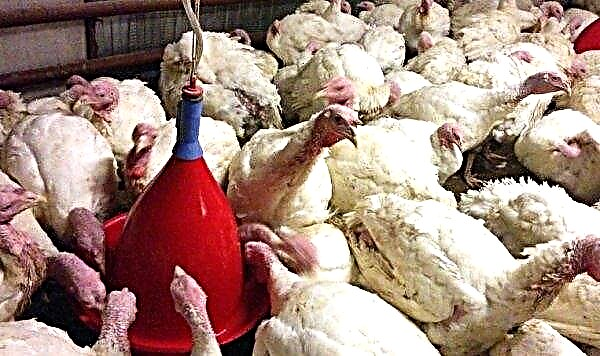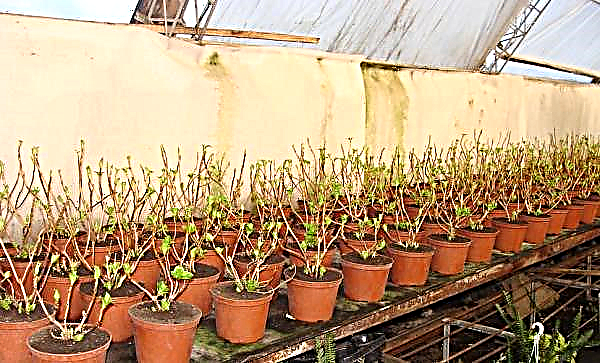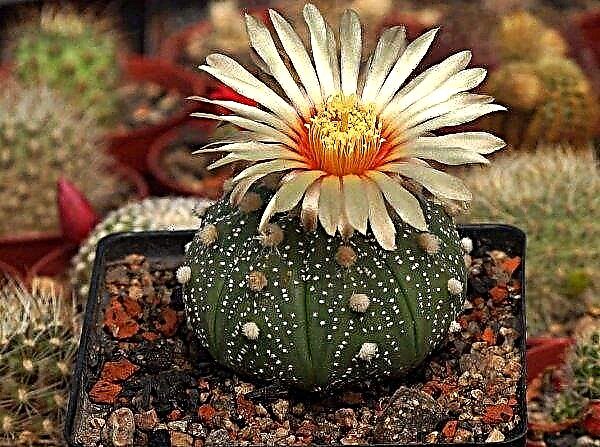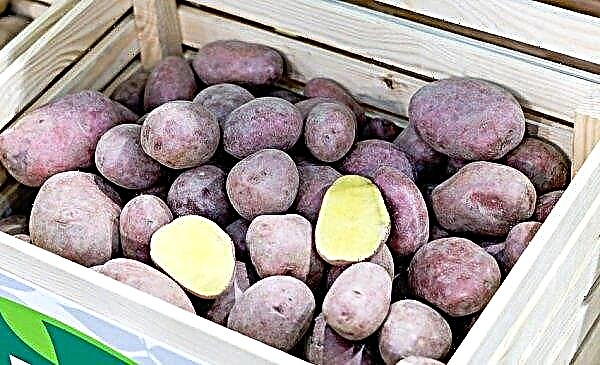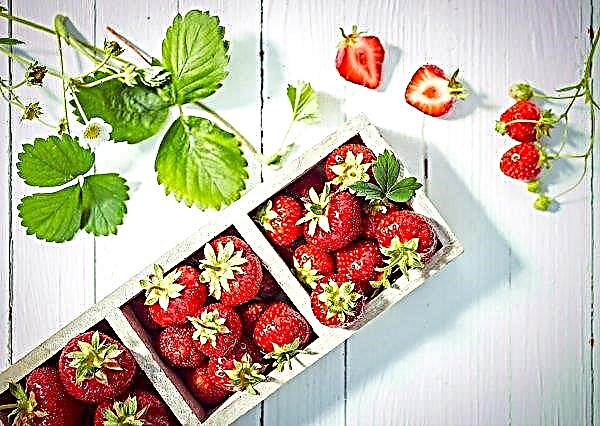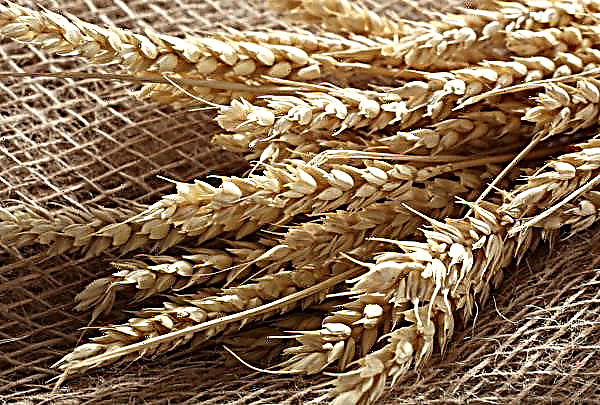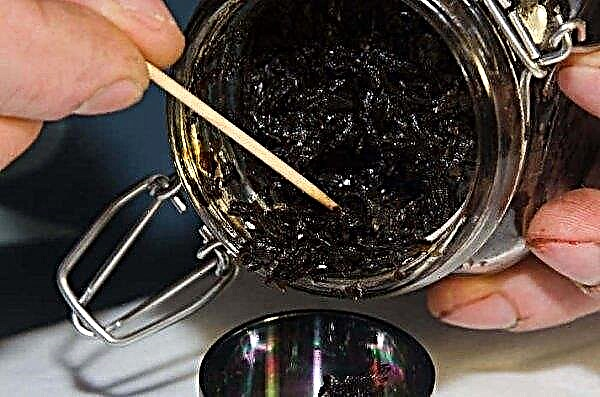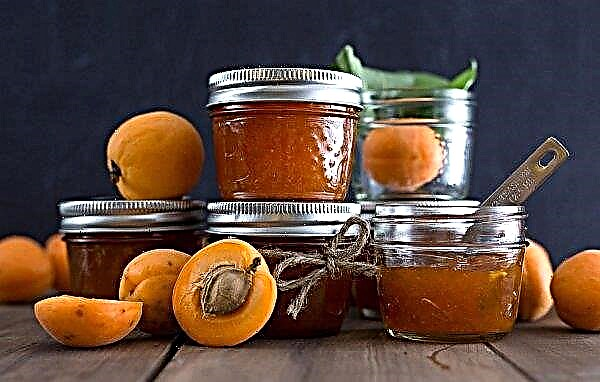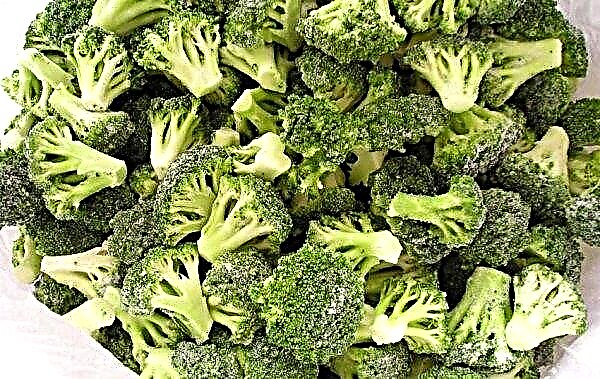Spicy herb cilantro (coriander greens) has been known to man for over five thousand years. As a spice, it is widely used in many national cuisines, and its useful properties have found their application in alternative medicine. About how to store cilantro for the winter, about the methods and rules for long-term storage of cilantro, as well as how long coriander can be stored at home, will be discussed in the proposed material.
Ways to store cilantro for the winter
Cilantro is a delicate plant, and its conservation is not always a simple process. At the same time, there are ways to preserve its valuable qualities for the long term.

In fridge
Fresh, freshly picked or purchased greens are stored in the refrigerator.
Using wet paper towels
To preserve greens with wet paper towels, you need to do this:
- With kitchen scissors or a sharp kitchen knife, cut off the dried ends at each stem of the plant, as well as remove all damaged or fading parts.
- Place the processed greens in a wide and low container and pour water, but so that it covers all the stems.
- Leave for 5-10 minutes to soak. This procedure soaks the plants with water and removes debris and dirt from them.
- Remove the greens from the water and transfer to a salad dryer (if there is none, you can dry the product with layers of paper towels). It is not necessary to achieve absolute dryness, the main thing is that there are no drops of water on the green.
- Spread the dried coriander on a piece of a damp paper towel. The size of the segment is determined so that it is possible to wrap a bunch of greenery from all sides.
- Wrap a bunch of greens on all sides with a damp towel.
- Place the wrapped greens in a plastic bag or in a sealed plastic container. Close and mark the packaging with the date of bookmark storage and a description of the contents. When packing, the following nuances must be taken into account: when placing in a plastic bag, you should leave about 2.5 cm of the upper part empty, squeeze out air and complete the packing; placing in an airtight container, it is necessary to monitor the density and reliability of the fit of the lid.
- Send to storage in the refrigerator.
Important! The paper towel that wraps the greens sent for storage should not be wet, only slightly moist.

Using dry paper towels
A method for storing coriander with dry paper towels involves the following:
- Rinse and sort out the greens, removing damaged and old fragments of stems.
- With kitchen scissors or a sharp knife, completely trim the dried ends.
- Using a salad dryer or paper towels, completely dry the greens. The best option is to spread the cilantro on a towel for several hours so that it remains in the open air, but excluding direct sunlight.
- Cover the bottom and walls of the sealed plastic container with a sheet of dry towel.
- Place cilantro on top with one layer and cover with another layer of towels.
- Alternate layers of greens and towels until the container is full, but so that the towel is at the top.
- Tightly and securely close the container and send it to the refrigerator.
- During the entire period of storage in the refrigerator - periodically check the product, inspecting it through the transparent side walls or opening the container for a very short time. Withered or discolored greens should be removed. If any moisture occurs inside the container, the container should be dried and the cycle of laying the greens for storage should be repeated.
Important! As a storage container with dry paper towels, you can use an exclusively plastic sealed container.
Video: How to keep cilantro fresh
In a container with water
To prepare for storage of seasoning in a container of water you will need:
- sharp kitchen scissors or a sharpened knife;
- glass container (can);
- plastic bag or bags.
Did you know? Coriander — an excellent antidepressant, its moderate use improves sleep, drives away despondency and anxiety. In addition, he is a natural aphrodisiac. To improve libido, it is recommended add to food seeds and herbs of the plant along with parsley, garlic and celery.
Procedure for bookmarking storage:
- Sort and rinse the plants.

- Dry on a paper towel.
- Using kitchen scissors or a knife, trim the bottom of each branch, but no more than 2/5 of the length. Cut off parts of the bottom of the stems can be removed.

- Fill the container with cool water. There should be enough water in the tank so that it covers the stems of the plant inserted in the jar, but does not touch its leaves.
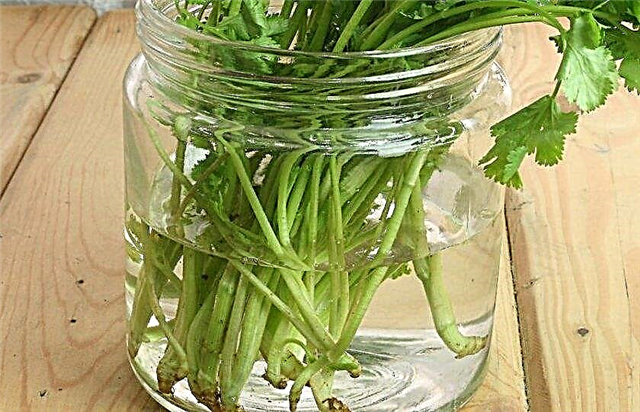
- Cover the container with vertically arranged in it (like flowers in a vase) coriander stems with a plastic bag. Around the throat of the can, the package can be fixed with an elastic band. A plastic bag will protect the plant from the damaging effects of air.

- The container covered by the package should be stored in a refrigerator.

- It is necessary to constantly control the color of the water in the bank - as soon as its color begins to change, the water must be changed. As a rule, water changes once every few days.
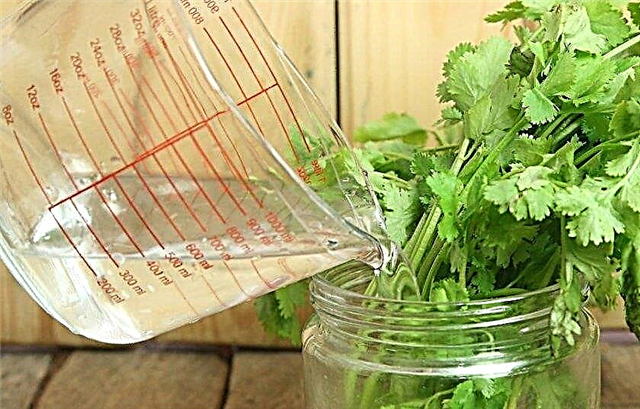
- Withering leaves or changing their color is a signal that the shelf life of the seasoning has expired.

Dried
This method allows you to save a special spicy smell of the plant. There are two ways to dry: naturally or in the oven.
Important! Naturally dried coriander should be stored in containers of glass, out of the reach of ultraviolet rays and high humidity.
Natural drying process
To dry cilantro in a natural way, you must:
- Carefully sort through the plant, removing the leaves with damage and inedible grass.
- Rinse the selected cilantro under running water and dry with a paper towel.
- Cut the dried plant into large pieces - if finely chopped, the coriander can dry out too much during the drying process.
- Cover the selected flat surface (pallet, board, etc.) with paper and spread the spice on top with one layer.
- For drying, transfer the surface with coriander to a dry, with adequate air circulation, sheltered from direct sunlight.
- Periodically (once a day) the spice should be mixed by hand.

How to dry cilantro in the oven
To prepare and dry the greens in the oven, do the following:
- Sort cilantro and wash under running water.
- Dry the selected and washed coriander on a paper towel and cut into large pieces.
- Spice on a baking sheet.
- Preheat the oven to a temperature of + 40 ° C and place a baking sheet with spices in it.
- Dry in the oven with the door open for five hours. The rustling and grinding of cilantro when trying to pick it up is a sign of readiness.
- After the specified period - remove the seasoning, transfer to a container of glass and store in a dry place.
Methods for long-term conservation of cilantro
If necessary, preserve spice over a long period of time, freezing is used. There are several ways to freeze spices, the most common of them are freezing in a bag, freezing in vegetable oil and freezing in butter.
How to freeze cilantro in a package
To freeze cilantro, you can use cellophane bags or special bags for freezing.
Video: Freezing cilantro in a package
Algorithm of actions:
- The plant gets over, unnecessary branches are deleted.
- The selected greens are washed with running water, the water is shaken off.
- The washed coriander is dried on a paper towel.
- Dried branches are cut for convenience (but you can not do this) and put into packages.
- Seasoning bags are sent to the freezer.
Important! Bags with coriander in the freezer should not be crushed on top by other products, otherwise the seasoning will lose its valuable qualities.
Freezing cilantro in vegetable oil
Save cilantro by freezing in vegetable oil as follows:
- Prepare a blender and molds for ice.
- The greens are finely chopped (up to 3 cm) and poured into a blender.
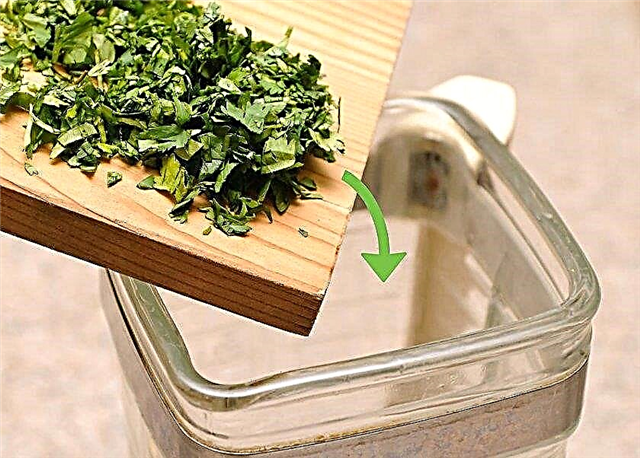
- Then vegetable oil is poured there at the rate of 80 ml per 50 g of chopped seasoning.

- In a blender, everything is mixed to a state of puree mass.

- After that, the resulting composition is decomposed according to the molds for ice (but the molds are not completely filled with the composition, since the volume of the composition will increase when frozen).
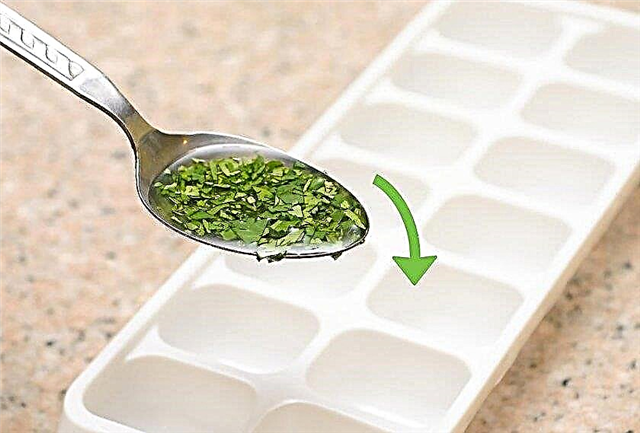
- Molds with the product are sent to the freezer.

- After freezing, dosed formed cubes are laid out in plastic bags and stored in a freezing chamber.

Freezing cilantro in butter
The algorithm for freezing a plant in oil is as follows:
- Grind the coriander and soften the butter.

- Mix the prepared ingredients in the proportion: 3 tablespoons of cilantro per 100 g of oil. If desired, add a little garlic, pepper, lime zest, other seasonings or herbs to taste.

- Place the well-mixed composition on parchment paper or foil and then wrap in the form of a roll.
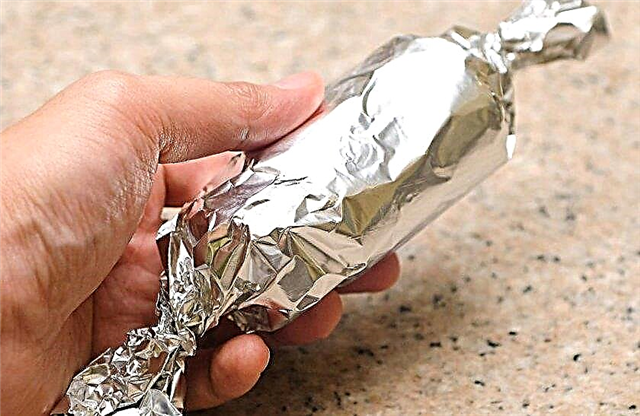
- The resulting "package" is placed in the refrigerator for 2-3 hours to completely solidify the oil.
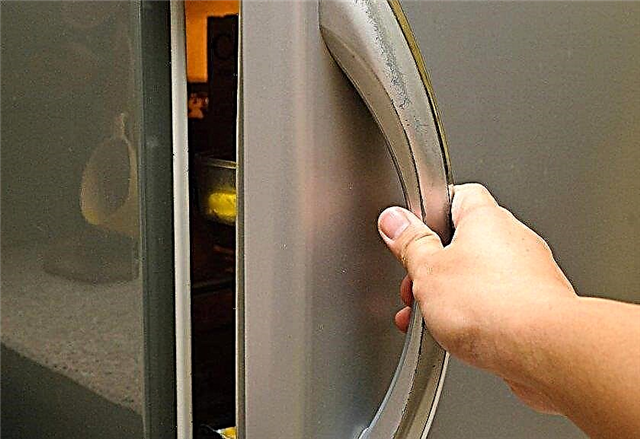
- After the specified period, remove the workpiece, place it in a bag of polyethylene and place it in the freezer compartment of the refrigeration device or in the freezer.

Using this method will give coriander a special taste and aroma. Coriander preserved in this way can be used in the preparation of first, meat or fish dishes, as well as a variety of sauces.
Shelf life of cilantro
The shelf life of coriander is determined by the method of saving.
Fresh
Fresh seasoning can be stored in a refrigerator:
- In a hermetically sealed container in the food compartment - no more than 7–10 days.
- In a closed container with water - 14-15 days.
In dried form
Dried cilantro should be stored in containers with good ventilation or in plastic bags with a lock, from one to two years.
Did you know? Candied coriander is a popular sweet dish of folk cuisine of Turkey and many Arab countries.
Frozen
The shelf life of frozen cilantro is determined by the method of freezing:
- Seasoning frozen without any additives can be stored for two months.
- Seasoning, frozen in vegetable oil, is suitable for use for three months.
- Seasoning frozen in butter should be consumed within a month, and if the butter has already been thawed and put back into the refrigerator, cilantro should be consumed over the next five days.

Cilantro is an extremely useful product. Proper laying and saving in compliance with the recommended rules will allow for a long time to saturate the diet with substances valuable to the human body.




















